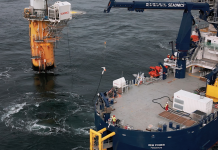In 2014, the leadership at Apex Clean energy decided to implement a Remote Operations Team to provide additional monitoring and control for Apex’s managed wind-power facilities. The Remote Operations Team would perform a number of critical, 24/7 operations — including wind-farm performance monitoring, SCADA system monitoring, downtime categorization reporting, generation forecasting, and more. A new, high-tech facility called the Remote Operations Control Center (ROCC) would be built at Apex’s Charlottesville, Virginia, headquarters to house the new team.
Apex leadership recognized that to monitor the data produced by their many informational systems, the Remote Operations Team would need a user-friendly visualization solution. The company decided to equip the Remote Operations Control Center with a video wall: a high-resolution display system where the team could monitor real-time video and data from various platforms.
Apex Clean Energy is an independent renewable energy company that builds, owns, and operates utility-scale wind and solar power facilities. With a team of more than 200 professionals and the nation’s largest wind-energy project pipeline, Apex is a leader in the transition to a clean energy future.
Selecting a Solution
David Grant, director of Remote Operations and SCADA Technology at Apex, led the effort to select a video wall solution for the new ROCC. Having successfully implemented a video wall system in a previous leadership role, Grant had valuable insights into the features that would be most important for the Remote Operations Team.
“I knew that the functionality and ease-of-use of the video wall controller would be critical,” he said.
After evaluating offerings from a number of providers, Grant and his colleagues chose CineMassive to deliver a turn-key video wall system for the ROCC. The solution would include an LCD display system, a video wall controller, and software. Grant cited the capabilities of CineMassive’s Alpha video wall controller as a major factor in the decision.
“Other companies’ controllers just didn’t offer the content flexibility and control that the Alpha provided,” he said.
Integral Role
Apex’s new Remote Operations Control Center and CineMassive video wall system were completed in August 2014. Since its installation, the CineMassive system has played an integral role in the Remote Operations Team’s 24/7 workflow, providing operators with real-time situational awareness of Apex’s management portfolio.
Inside the ROCC, operators sit at workstations facing their CineView LCD video wall. The bright, 5×2 array of ultra-narrow-bezel screens displays an assortment of live video, maps, television news, and active data feeds.
The team uses the video wall to monitor wind-farm performance data, energy-market prices, forecasting models, weather patterns, and live camera feeds from the wind farms. An Alpha video wall controller enables all of these applications to be displayed simultaneously, allowing the team to create a real-time operating dashboard on the displays.
“The Alpha lets us display whatever we want, whenever we want, however we want, so we’re able to visualize multiple data systems on the video wall simultaneously,” Grant said.
Software Interface
Operators interact with the system through the Alpha’s CineNet software interface — a multi-user platform accessible from their workstations. With CineNet, they can arrange content sources anywhere on the displays and freely scale, crop, and zoom into content sources in real-time. This functionality lets them adjust their view on the fly and investigate areas of interest in live data and camera feeds.
“One of our responsibilities is to monitor the safety of the employees working at our substation control yards,” Grant said. “With CineNet, we can display live video feeds from those locations and actually zoom in on individuals to ensure their safety remotely.”
The team also leverages CineNet’s Layouts feature, which allows it to build and save arrangements of content sources to be displayed on the video wall during specific situations. Operators can create layouts on the live video wall or use CineNet’s Preview Canvas to build them “offline.” Once saved, their purpose-built layouts can be pushed instantly to the displays when needed.
“When executive management and asset managers walk into the operations center, we can give them an immediate overview of their portfolios on the video wall,” Grant said. “Or, if we have a customer coming in and we want to show them data and video that pertains to their assets, then we can pull up a layout that shows those specific content sources.”
The video wall system also plays an important role in alerting operators to critical alarms. If an event triggers Apex’s centralized alarming program, an alert not only displays on the alarm application itself, but also pops up on the video wall, ensuring that it cannot be missed.
When an alarm is received, operators can quickly push relevant video and data feeds to the video wall, where they can continue monitoring the situation in real-time as they coordinate their response.
The Benefits
By using their CineMassive video wall system to visualize and manage their critical data, the Remote Operations Team is able to work efficiently and effectively to support Apex’s clean-energy assets.
Pleased with the outcome of the project, Grant said the video wall system is not just visually impressive, but also genuinely useful to the team.
“The data you see on the screens is a truly functional view,” he said. “Every single thing on the video wall adds value.”
Looking to the future, Grant said he is also happy to have implemented a visualization system that can scale and develop along with the organization itself.
“As Apex continues to acquire new assets and grow as an organization, the CineMassive system gives us the flexibility to evolve and expand the information we’re visualizing,” he said.
Source: CineMassive
For more information, go to www.cinemassive.com



























